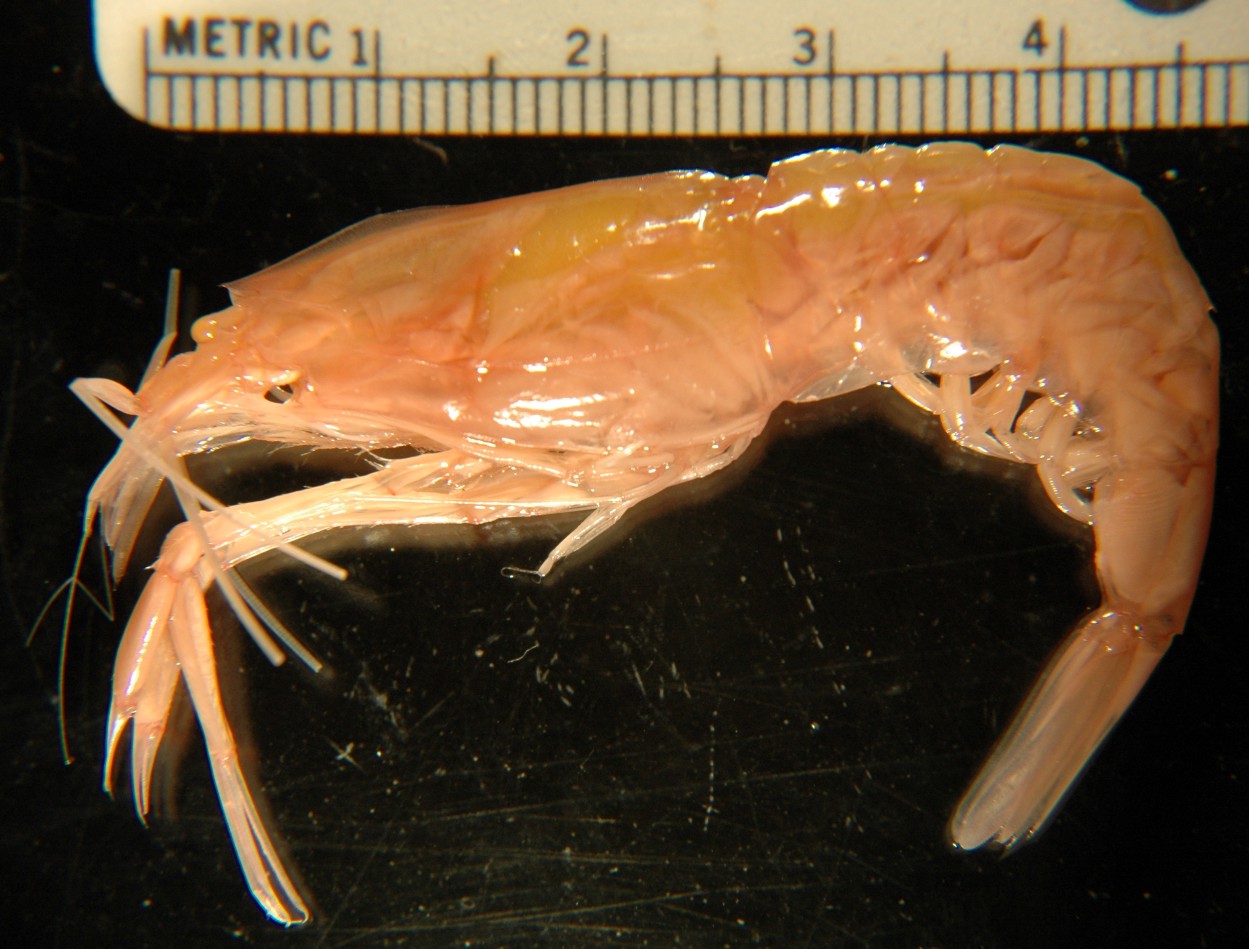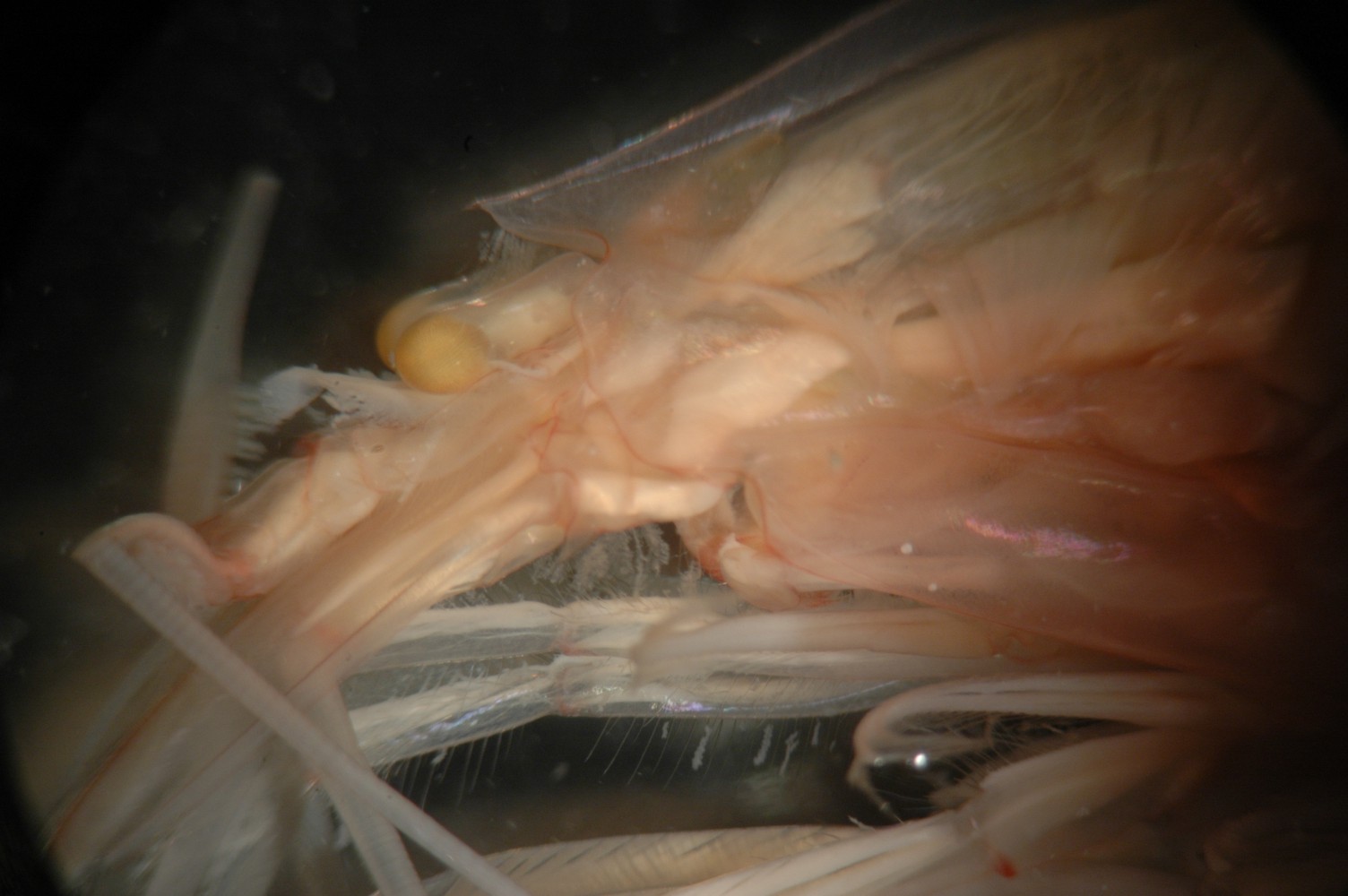Parapasiphae sulcatifrons Smith, 1884Common name(s): Grooveback shrimp |
|
| Synonyms: |  |
| Phylum Arthropoda
Subphylum Crustacea Class Malacostraca Subclass Eumalacostraca Superorder Eucarida Order Decapoda [Informal Group Natantia] Suborder Pleocyemata Infraorder Caridea Family Pasiphaeidae |
|
| Parapasiphae sulcatifrons from off Point Conception, CA | |
| (Photo by: Dave Cowles, Sept 1995) | |
How to Distinguish from Similar Species: The two pairs of enlarged, chelatepereopods (photo) distinguish this species from shrimp in other families. The other local Pasiphaeids, such as Pasiphaea pacifica, are strongly laterally compressed and may be partly transparent. Members of genus Pasiphaea also do not have a true rostrum--instead, a median spine from the dorsal carapace projects up just behind the front of the carapace, looking somewhat like a rostrum. A related species also found bathypelagically in our region, Parapasiphae cristata, differs because P. sulcatifrons has no teeth at the base of the rostrum (photo) and the fingers of the second chelae are shorter than the palm, while Parapasiphae cristata has two teeth at the base of the rostrum and the fingers of the second chelae are longer than the palm.
Geographical Range: British Columbia to Baja California, Indo-Pacific, Atlantic, off eastern Australia
Depth Range: Deep mesopelagic
Habitat: Midwater
Biology/Natural History: Some notes on the biology of Parapasiphae species, and a key to the different species can be found in Wasmer, 1967, 2005
| Return to: | |||
| Main Page | Alphabetic Index | Systematic Index | Glossary |
References:
Dichotomous Keys:Kozloff 1987, 1996
Wicksten, 2009
General References:
Butler,
1980
Scientific Articles:
Chace, F.A., Jr., 1940. Plankton of the Bermuda Oceanographic
expeditions. IX: The bathypelagic caridean
Crustacea. Zoologica
25: 117-209
Hendrickx, Michel E. and Flor Delia Estrada Navarette, 1996. Los Camarones Pelagicos (Crustacea: Dendrobranchiata y Caridea) del Pacifico Mexicano. Comision Nacional para el Conocimiento y Uso de la Biodiversidad. ISBN 968-29-8882-9
Wasmer, Robert A., 1967. Bathypelagic shrimps (Penaeidea and Caridea) from the eastern North Pacific. Master's thesis, Walla Walla College, College Place, WA. 86 pp.
Wasmer, Robert A., 2005. A remarkable new species of the pelagic shrimp genus Parapasiphae Smith, 1884 (Crustacea: Decapoda: Pasiphaeidae) with double eyes. Proceedings of the Royal Society of Washington 118:1 165-175
Web sites:
General Notes and Observations: Locations, abundances, unusual behaviors:

This view is of a preserved specimen captured between 700-750 m depth
in San Clemente Basin, CA in July 1984. Note the large, chelate first
and
second pereopods.

This closeup of the chelate first (left) and second (right) pereopods
shows that though they are both chelate, the chelae are very different
from one another.
Photo from the preserved specimen above.

This species has a short but well-developed rostrum but no prominent
lateral spine close to the anterior end of the carapace.
Photo of preserved specimen
Authors and Editors of Page:
Dave Cowles (2006): Created original page